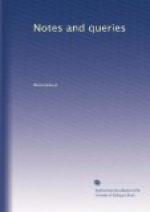The editors state that richly decorated drinking-horn was formerly preserved, with great care, in the family of Oldenburg; but that, at the present time [1818], it is at Copenhagen.
The same story is related from Hamelmann’s Oldenburg Chronicle, by Buesching, in his Volksagen (Leips. 1820), p. 380., who states that there is a representation of the horn in p. 20. of the Chronicle, as well as in the title-page of the first volume of the Wunderhorn.
Those who are accustomed to the interpretation of mythological fictions will at once recognise in this story an explanatory legend, invented for the purpose of giving an interest to a valuable drinking-horn, of ancient work, which belonged to the Counts of Oldenburg. Had the story not started from a basis of real fact, but had been pure fiction, the mountain-spirit would probably have left, not silver gilt, but a gold horn, with the count. Moreover, the manner in which she suffers herself to be outwitted, and her acquiescence in the loss of her horn, without exacting some vengeance from the incredulous count, are not in the spirit of such fictions, nor do they suit the malignant character which the legend itself gives her. If the Oldenburg horn is still preserved at Copenhagen, its date might doubtless be determined by the style of the work.
Mount Osen seems to have been a place which abounded in supernatural beings. Some elves who came from this mountain to take fresh-brewed beer, and left good, though unknown money, to pay for it, are mentioned in another story in the Deutsche Sagen, (No.43. vol. i. p. 55.)




